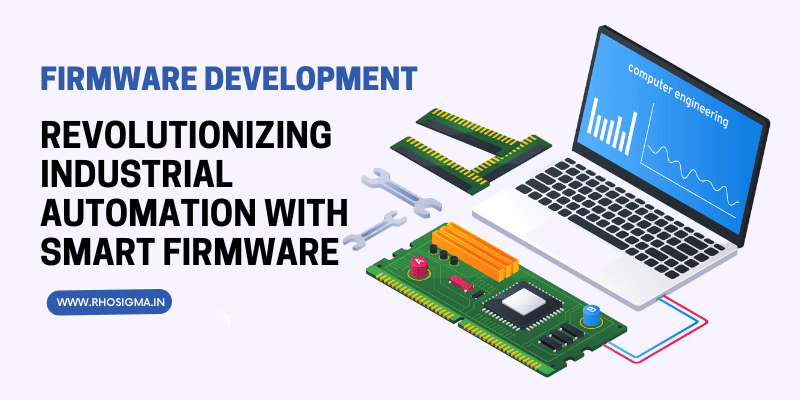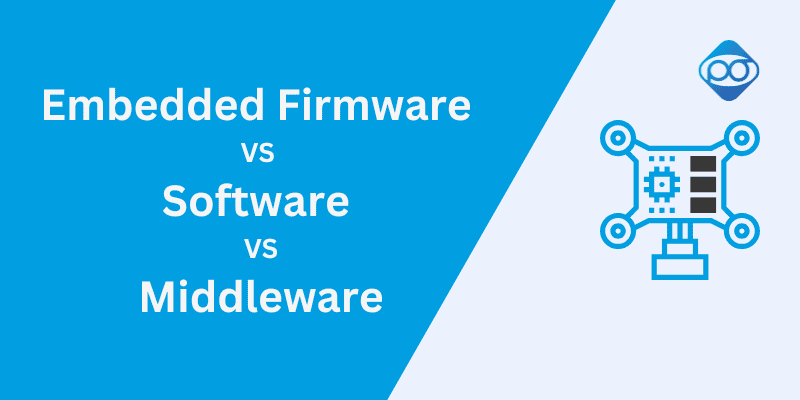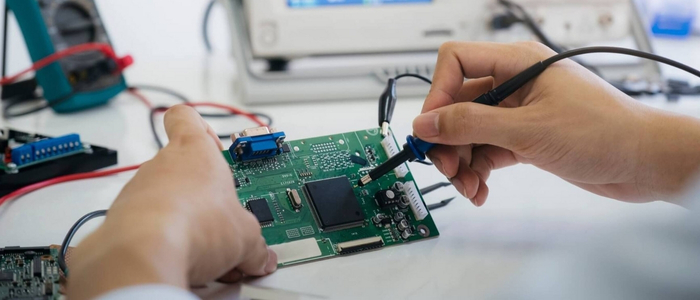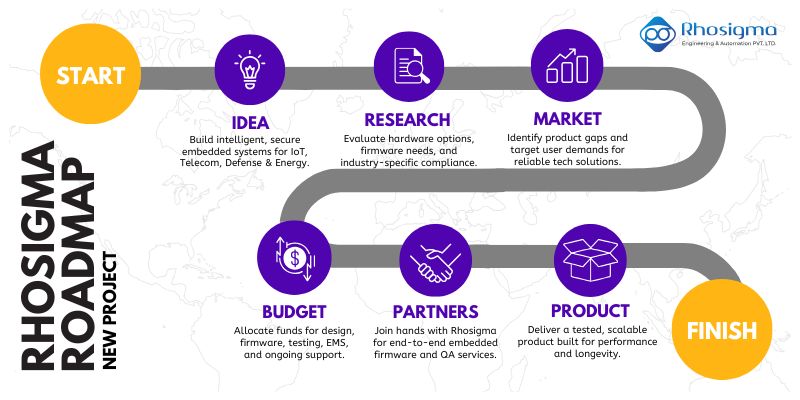Embedded Software Testing: The Ultimate Guide

This guide covers the fundamentals of embedded software testing, including the types, challenges, and best practices for reliable and efficient embedded systems.
This guide covers the fundamentals of embedded software testing, including the types, techniques, challenges, and best practices for reliable and efficient embedded systems.
Have you ever found yourself running late on a project? Well, What’s the first thing that usually gets skipped when time’s running out? Testing, right? And what happens after that, is a bug-ridden product is delivered to the client, often leading them to replace you with your competitors.
It might seem small at the time, but skipping testing can lead to big problems.
Thorough testing is necessary to make sure that the software works correctly. Testing ensures the device is reliable, efficient, and secure.
In this blog, we’ll break it all down for you. Stick with me and you’ll have a clear picture by the end!
What is Software Testing
In simple terms, embedded software testing is the process of making sure the software that runs inside a device works perfectly with the hardware it’s paired with. It’s all about ensuring the system runs smoothly and does exactly what it’s supposed to.
Importance of Embedded Software Testing
Embedded systems are everywhere, From smartphones to the cars we drive even in the appliances of our homes. These systems rely on software to function correctly, but things can easily go wrong with the complexity of hardware and software working together.
This is where embedded software testing becomes important because without testing even the smallest bug or glitch can cause major issues.
A malfunctioning embedded system can easily lead to safety concerns, device failure or poor experience—problems no company wants to face.
Example,

One of the most famous examples of how a tiny mistake can lead to big consequences is the Mariner 1 mission to Venus mishap It all came down to a simple typographical error.
The code DO 10 I = 1.5
was supposed to be DO 10 I = 1,5
The error in the loop instruction led the guidance system to fail, causing the mission to lose its way.
The correct code would have told the system to run a loop from 1 to 5, but that small typo completely changed the outcome and caused the loss of $80million
This incident is a perfect reminder of why **embedded software testing** is so important. In critical systems, especially those in space missions, even the smallest error can cause major problems. It’s the attention to detail and thorough testing that helps catch these mistakes before they become disasters.
In general, testing is important for 5 reasons:
- To find bugs in the software
- To reduce risk
- Improve Performance
- Save cost and time
- Enhance customer satisfaction
Secure your devices and build customer trust with our expert embedded software testing services.
Types of Embedded Software Testing
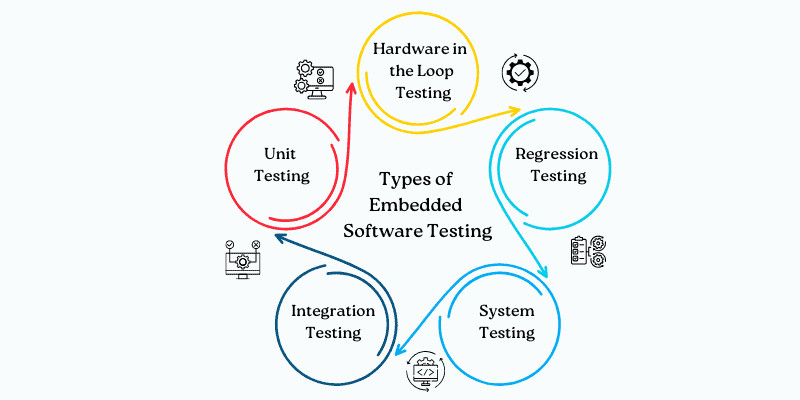
Unit Testing: In unit testing, each component or piece of software is tested to make sure it works correctly.
It helps to catch the errors early before they affect the whole system.
Integration Testing: Integration testing ensures that the different components of software once combined, function correctly as a whole.
System Testing: It is like testing the whole machine, It ensures that the entire system works as expected. It’s a big-picture test.
Hardware-in-the-Loop (HIL) Testing: Here the software is tested using real hardware. It’s like simulating how the software will interact with the actual physical system when it’s up and running in the real world.
Regression Testing: This is done whenever the software is updated or changed. This test ensures that new changes or fixes haven’t caused new problems.
Embedded Software Testing Instruments
Various tools support embedded software testing, categorized as:
Static analysis tools: These tools find bugs without running the code. It analyzes tools to scan the code to detect errors, security risks, and standard violations before running the program.
For example, Klocwork Insight – Checks source code for issues and ensures coding, and Parasoft DTP – Identifies problems early in development to reduce future errors.
Dynamic analysis tools: These tools test the code while executing to find runtime errors like memory leaks or crashes.
Unit testing framework: Allows developers to write and run individual code blocks.
Integration testing tools: They ensure that the different parts of the system communicate correctly and work smoothly.
HIL simulation tools: They simulate real-world hardware conditions and check software without real hardware
Code coverage tools: They measure the effectiveness of the tool.
Performance profiling tools: It identifies the speed and effectiveness issues.
Commercial Embedded Software Testing Tools
TESSY: It automates the unit testing, generates test cases, and provides code coverage
Eggplant: Focuses on the user interface, API, and system-level testing it also includes performance testing.
Parasoft DTP: Combines static analysis, unit testing, and test management in one platform.
Klockwork Insight: Specializes in static code analysis to detect security flaws and coding violations.
Vector CAST: An automation tool used for safety-critical applications.
How to Perform an Embedded Software Test
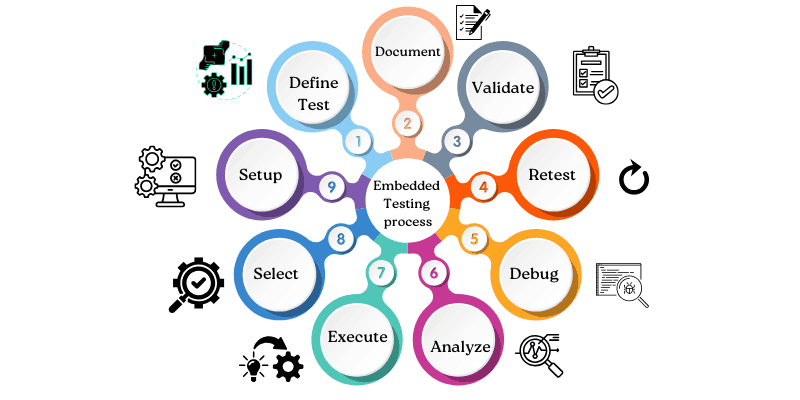
- Start by defining the test requirements, it means identifying what the system is supposed to do, the hardware it’s interacting with, and any performance or safety standards it must meet. it will guide you in your test planning.
- Set up a testing environment. This could include, a development or test board, Debugging tools, Emulators, or simulators.
- Choose the right testing method.
- Execute the test, execution involves creating tests, running them, and noting the logs, outputs, and errors for analysis.
- Analyze the results, if any test fails, debug the software to find the root cause of the issue.
- Once the issue is fixed, perform regression testing to ensure that the changes haven't caused any problems.
- Once your software passes all test cases and works correctly in all scenarios, perform final validation and ensure it meets all requirements.
- In the end, document all the tests you have performed and issues you have encountered, it will help you to track progress, and share insights with a team and will be crucial for future reference.
Benefits of Embedded Testing
Cost saving: Embedded testing helps to detect issues early in the development cycle and fix bugs during the design or coding phase. Thus, it ultimately saves money, time, and resources.
Improved product reliability: Embedded systems are often used in critical applications like medical devices, automobiles, and industrial machines. Testing ensures that the system operates reliably under different conditions and minimizes failures and unexpected crashes.
Better Security: Embedded testing helps to identify vulnerabilities and strengthens security by preventing unauthorized access, malware attacks, or system manipulation.
Enhance customer satisfaction: A well-tested embedded system provides a smooth user experience with minimal errors, Thus it enhances user satisfaction and builds trust with a good brand reputation.
Prevent hardware damage: Embedded software directly interacts with hardware components. Thus if the software has any defects, it can cause overheating, excessive power consumption, or even physical damage to the device. Here proper testing ensures, that the software operates safely within the hardware limit.
Challenges in Embedded Testing
Dependency of Hardware: Embedded software is designed to work on specific hardware. If the hardware changes, even a small change requires re-testing. Thus this dependency makes testing more complicated.
Costly & Time-consuming Process: Embedded testing requires specialized hardware, testing tools, and experienced testers, and the process involved is often lengthy, especially for safety-critical applications, increasing overall development costs.
Complex integration: Embedded systems often need to communicate with other devices like Sensors or cloud platforms. Here ensuring seamless integration across different environments becomes challenging.
Lack of standard testing tools: Embedded systems require customized tools and setups and this makes the testing process more complex and dependent on specialized expertise.
Emerging Trends in Embedded Software Testing

AI-Driven Testing: AI is making testing smarter by automating tests, identifying defects faster, and improving overall test coverage.
IoT Security & OTA Updates: IoT security and Over-the-Air (OTA) update testing ensures smooth, remote software upgrades.
Shift-Left Testing: Testing is moving earlier in the development cycle to catch issues sooner, reduce cost, and improve software quality.
Cloud-based Testing: Cloud platforms provide scalable and flexible testing environments, making it easier to test complex embedded systems.
New Tech, New Challenges: Innovations like blockchain, machine learning, and AR bring unique testing requirements, demanding new strategies and tools.
Effective Practices for Embedded Software Testing
To make the most of your testing efforts, consider these best practices:
- Don't wait until the end of development to begin testing. you can integrate testing from the start as it can prevent costly fixes and improve overall software quality.
- Make testing easier by incorporating features that provide access to the system. Examples include JTAG connectors, DB9 connectors, and serial ports.
- Adopt coding practices that support testability, such as modular design and clear interfaces.
- Document your testing approach, goals, scope, and processes because, a structured plan ensures thorough testing, and prevents gaps.
- Prioritize tests based on critical functions, high-risk zones, and common user interactions.
- Use tools to automate repetitive tasks, regression testing, and performance testing.
- Make sure your tests cover enough of the code base.
- Verify that changes haven't brought in new bugs. Utilize test impact analysis to focus on affected code and tests.
- Encourage open communication between development, testing, and operations teams.
- Use a methodical system for managing defects.
- Regularly review and refine your processes.
Summing up!
Embedded software testing is a crucial step in ensuring the reliability, security, and efficiency of embedded systems and by investing in robust embedded testing you can build reliable, future-proof products that stand out.
Are you ready to take your next step? Do you need expert testing to ensure your product’s reliability? Let Rhosigma help you with embedded testing and quality assurance services that can optimize your product’s performance, get in touch today!
